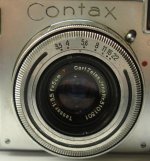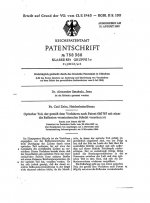Santino,
H. Thiele's reference book (p. 72) says: "card #295, Tessar, 1/3.5, 5cm, calculated 1931-02-27, batch of 1.200, s/n 3.100.601-3.101.800, Contax mount, prod. date 1947-12-18"
So your lens is a post-war lens of a pre-war design.
Lens coating has been discussed in this forum, I suppose, but without going into too much detail (and quarreling who was the first to invent it), I will try to summarize what I think can be said safely.
The German patent for lens coating was registered by Alexander Smakula of Carl Zeiss Jena in 1935, issued in 1937, and published in November, 1944 - indicating that it was kept as a secret until it had become clear that the allies were capable of producing coated lenses as well as their axis counterparts; there are rumours on the net that lens coating had been invented earlier (by simply tarnishing lenses on the air or immersing them in calcium salts as this had been known since the turn of the last cerntury), and that viable coating had been invented by the Carl P. Goerz factory in Berlin for their field glasses, but I have not seen proof of the latter; obviously a similar invention had been made in the U.S. in the mid-thirties, I have seen a document about that but keep forgetting the name of the inventors. Japanese periscopes are also being said to have been coated prior to WWII, but I have also not seen any documents.
As far as CZJ is concerned, coated and uncoated lenses were produced during the pre-war period and wartime, and there is much in favour of the theory that coated lenses were primarily sold to the military and to researchers; at least my issue of "Neue Foto Schule" by Hans Windisch, a very detailed book for the amateur market, does refer to light loss along reflecting surfaces, but not to lens coating at all as late as 1940, and CZJ advertising from the 1930s and early 1940s does not, either.
By the end of WWII it was clear that lens coating would be available to anybody wanting to put some effort in the issue - and that the CZJ patents would not be of much interest in an occupied country; I have often heard the claim that every lens leaving the CZJ plant after WWII was coated (this issue would still have to be settled in my opinion, circumstances seem to have been rather chaotic, serial numbers from some 2.700.000 were in disarray, coated lenses were not always marked with the red "T", uncoated lenses were coated after-market - we will probably never know).
I have enclosed a post-war document about the Smakula lens coating patent from which, in the middle of the page, the exact patent dates can be derived.
This being said -
forget about the stuff and enjoy shooting that lens!
Jesko



